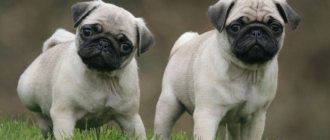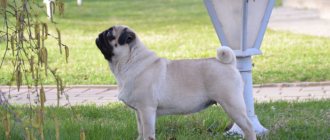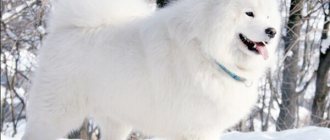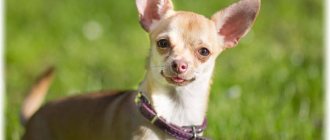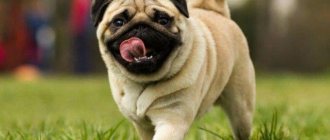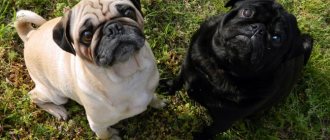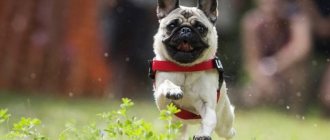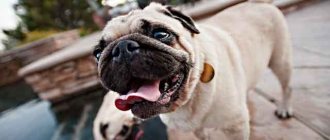The history of pugs is as interesting and unusual as they themselves. These short, stocky dogs with flattened wide muzzles and intelligent, attentive gaze of expressive brown eyes appeared in ancient times.
Over the centuries, the breed has improved, while at the same time maintaining its best qualities: devotion to the owner, cheerful and funny disposition, endurance and, of course, such features of its appearance as a tail curled into a ring and wrinkles on the forehead, similar to signs of some kind of... that of ancient writing.
History of the breed
Pugs appeared in China during the Han Dynasty (206-200 BC). Some historians believe they are related to the Tibetan mastiff. They were highly valued by the Chinese emperors and lived in luxurious apartments, sometimes even under the guard of soldiers.
Pugs are one of three types of short-nosed dogs known to have been bred by the Chinese: the Lion Dog, the Pekingese, and the Luo Jie, which was an ancient pug. In the late 1500s and early 1600s, China began trading with European countries. The first pugs brought to Europe reportedly came with Dutch traders, who named the breed Pug, which is still used today.
Pugs quickly became favorites of royal courts throughout Europe and even played a role in the history of many of these families. In Holland, the Pug became the official dog of the House of Orange after the Pug was rumored to have saved the life of William, Prince of Orange by warning him of the approach of the Spanish in 1572. When William of Orange (later called William III) traveled to England in 1688 with his wife Mary II to take the throne from James II, they brought their pugs with them.
It is known that black pugs existed in the 1700s because the famous artist William Hogarth was a pug enthusiast. He depicted the black pug and many others in his famous paintings. In 1785, Goya also depicted pugs in his paintings.
The famous Frenchwoman, Josephine Bonaparte, had a Pug named Fortuna. Before marrying Napoleon Bonaparte, she was imprisoned in Le Carme prison. Since her beloved pug was the only “guest” she was allowed to visit, she hid messages in his collar to pass on to her family.
In the early 1800s, Pugs were standardized as a breed with two lines becoming dominant in England. One line was called the Morrison line and was reportedly based on the royal dogs of Queen Charlotte, wife of George III. another line was developed by Lord and Lady Willoughby d'Eresby and was based on dogs imported from Russia or Hungary.
Pugs were first exhibited in England in 1861. The stud book began in 1871 with 66 pugs in the first volume.
Meanwhile, in China, pugs continued to be bred by royal families. When the British captured the Chinese imperial palace in 1860, they found several pugs and brought them with them to England. Two pugs named Lamb and Moss were brought to England.
Pugs became very popular during the Victorian era and were featured in many paintings, postcards and figurines of the period. They were often depicted with wide, decorative collars or large bows on short, thick necks.
How did it appear?
Scientists suggest that brachycephaly and changes in the shape of the skull, which appeared in the ancestors of modern pugs, are associated with mutations. This could be due to close inbreeding, which was widely used in dog breeding in the past.
The ancestors of pugs are considered to be miniature mastiffs, which were kept by Buddhist monks 2500 years ago and which somehow ended up in the imperial palace.
It was probably a gift to the ruler from one of the monasteries where these dogs were kept and bred. Once in the emperor's palace, small mastiffs became one of two breeds, representatives of which were only allowed to be kept by the highest nobility.
But, unlike the Pekingese, who never left the imperial palace, pugs also lived in the mansions of the highest Chinese nobility.
At the same time, special conditions were created for each of these dogs: she was fed the best varieties of meat and rice, and was also looked after by a specially hired person.
In order to reduce the risk of theft of a precious pet, collars with bells were placed around their necks.
This is interesting! Representatives of this breed became so popular in ancient China primarily due to their folds on the forehead, in which people saw writings allegedly left by the Buddha.
Probably, the fact that with their shortened muzzle and strong build these dogs are very similar to the mythical guardian lions, sculptures of which can still be seen today near ancient Chinese palaces or temples, also played a role.
Pug character
- Obedient
- Smart
- Savvy
- Playful
- Funny
- Devoted
What conditions make up a dog's character? It is widely believed that the character of a four-legged pet is determined at the genetic level. Also, many people close to cynology argue that character traits are nothing more than the consequences of training and daily upbringing of a puppy. The conditions under which the pet is kept also play an important role. You should not expect your pet to be sociable and friendly towards people if he has been shouted at since childhood, waved at with a leash, or with a newspaper.
Experienced dog breeders will certainly say that if you want to achieve mutual understanding with your own pet, then you must match in temperament and in some character traits. To correctly choose the breed that suits you, first study this issue theoretically: consider the exterior of the dogs you like, read the breed standard, pay attention to the description of the temperament and characteristics of the breed's behavior, ask questions to the real owners of the breed you are interested in. If, in theory, you are satisfied with the breed of your future pet, go to a nursery, or to people engaged in private breeding. A competent breeder who cares about his breed will readily respond to your requests for help in selecting a puppy. It is difficult to say with certainty what kind of character your chosen dog will grow up to be in such a short period of time. There are several simple tests with which you can choose a little friend with the qualities you need.
Video
* We invite you to watch a video about the Pug . In fact, in front of you is a playlist in which you can select and watch any of 20 videos about a given dog breed by simply clicking on the button in the upper right corner of the window. In addition, the material contains quite a lot of photos. By looking at them you can find out what a Pug looks like.
In this article:
|
Pug: breed features
- Pugs are stubborn and difficult to train. It is recommended to train with other dogs.
- Pugs cannot tolerate heat and high humidity due to their short muzzle.
- When your pug is outside, monitor him closely for signs of overheating.
- Pugs are domestic dogs and should not be kept in a yard.
- Despite their short fur, pugs shed heavily.
- Pugs wheeze, snort and snore loudly due to the structure of their faces.
- Pugs are susceptible to such a specific disease as chronic corneal erosion, so it is necessary to pay great attention to the condition of the eyes.
- Prone to obesity.
- Pugs need constant human contact. If you have a pug, expect him to follow you around the house, sit on your lap, and sleep in the same bed with you.
Color variations
The breed standard allows the following color options:
- black – completely black coat without interspersed hairs of light or white color;
- beige or apricot - wool of warm shades from cream to golden;
- silver is a coat of a cool light gray shade that does not turn into white.
For dogs of apricot and silver color, it is mandatory to have a dark mask on the face.
Training and education
Pugs are friendly and sociable dogs, but they are quite stubborn, so training them seems to be a very difficult task, without a guaranteed result.
Submitting a dog doesn't always work. The principle of complete submission of the pug to the owner is an outdated method. This theory was formulated based on observations of packs of wild wolves, but they were kept in captivity and, of course, experienced stress. The stress condition forced wolves to show aggression towards each other, but in the wild they do not show aggression to each other - they live together and interact with each other. You need to perceive yourself as the more experienced and mature member of the pack, who is responsible for guiding the new member (pug puppy) and teaching him good behavior, as well as correcting him if necessary. It is important to remember that pug puppies learn a lot on their own. They are very inquisitive, love to explore new territories and, of course, experiment. Puppies tend to repeat actions they enjoy (like playing with a toy). They do not repeat actions that cause them pain (for example, destroying a nest and getting bitten). If your pug puppy misbehaves, ignore him and praise him when he does the right thing. Reward your puppy for following commands and good behavior. Do not neglect these tips. After all, constantly hearing “you can’t” all day long is unbearable. This is a small child who wants to know everything and get his portion of treats as a reward for not eating your favorite rug, going to the toilet outside, bringing you a ball, and so on.
Set rules and monitor their implementation
It's worth enrolling your pug puppy in obedience training classes. These classes will allow you to understand exactly what actions will allow you to control your dog’s behavior. You will be able to spend more time with your puppy, establish contact and socialize around other dogs.
Adviсe
- Training a pug puppy should be done with the help of positive motivation; watch carefully special films about this technique. The Canine Translator film series from National Geographic is suitable.
- If you need to leave your puppy at home alone for 2 hours or more, then ask someone to come to him.
- Be sure to schedule your pug puppy an appointment with the vet as soon as possible. The doctor will carefully examine him and give him vaccinations that will protect him from dangerous diseases.
Attitude towards children and pets
Pugs love children. Although the Pug is small, it is not as fragile as some other small dog breeds, making it a good choice for families with children. Always supervise any interactions between dogs and small children. Teach your child never to approach any dog while it is sleeping or eating, or to try to take food from it. No dog should be left unattended with a child.
A properly trained and socialized pug will get along well with other pets.
Where to buy a pug puppy?
A specialized kennel is the best place to buy a good pug puppy. If pedigree and thoroughbred are important, then it is better to hire an experienced dog breeder to help. If not, then you can trust your heart. On nursery websites, there are customer reviews that will help you navigate. A little secret or life hack: visit a dog show where the desired breed will be presented. Chat with the owners of the breed, ask about the nuances, find out where they purchased the puppies. True dog breeders live for their pets, so they will be happy to answer any question and give valuable advice. Typically, nurseries send their representatives to exhibitions, where there is a chance to meet in person and take a business card.
How to choose a strong and healthy pug puppy
The day has come to go to the nursery for a cute puppy. Babies should be kept in a clean enclosure, without a specific unpleasant odor, which is very important. First of all, the breeder will demonstrate the numerous awards that his pets have received. Listen carefully, but don’t be easily fooled by all the big titles and championship accolades. If possible, you need to look at the parents of the future pet. Top 10 signs that will help you choose a healthy pug puppy:
- shiny and moist nose;
- clean ears, pink;
- lively, clear look;
- clean eyes, without any discharge;
- healthy skin, without parasites, sores and acne;
- silky, shiny coat;
- lymph nodes of normal size;
- tail without creases;
- no bloating.
A good proof that the animal is healthy is a written document of purchase and sale. If the pug puppy develops abnormalities over time, according to the contract, the pet can be returned. Having “insurance” with the buyer will reduce the risk that the seller will slip in a problem animal.
Age for adoption
- Professional Russian dog breeders advise buying 8-10 week old puppies. At this age, the baby should already be vaccinated, toilet trained, and receive basic education.
- An important point: it is not recommended to take a puppy home immediately after separation from its mother. Until 9 weeks of age, the baby learns dog language and learns to communicate with its own kind. He needs to spend several weeks in a doggy daycare.
- A professional breeder knows that a pug puppy less than 6 weeks old should not be given away. A very small puppy can only be given to an experienced owner who knows how to raise it correctly. This option is not suitable for a beginner.
- Depending on the breed, the puppy can be picked up earlier or later than 10 weeks of age. Large dogs grow more slowly, so it is recommended to remove them from kennels at the age of 3 months. Puppies of such breeds should gradually build up bone and muscle tissue, without sudden jumps, in order to avoid problems with the musculoskeletal system.
- For show- or breed-class pug puppies, the age of “adoption” can only be 6-9 months. This is a mandatory condition, because it is at this age that the makings of a champion and the distinctive signs of thoroughbred are revealed. You need to have patience to get a future titled champion.
Note : even the most expensive pug puppy cannot be 100% guaranteed to become a champion. The breeder’s job is to assess the potential and make a forecast. Next, you need to raise the puppy and train it for a long time in order to realize the makings of a champion.
Documentation
- The pug puppy has a mark in the groin area or it may be on the ear, as well as a puppy card (metric). The codes on the card and on the stamp must be identical.
- Metrica is the primary document that is issued for a puppy when it reaches the age of 45 days. Next, a qualified dog handler examines the babies and notes any defects found. The owner of the dog, if desired, can change the metric to a new document, pedigree, at the age of 6-15 months. This document will allow the pet to participate in breeding.
- Another document for the puppy is a veterinary passport, with mandatory vaccination and deworming notes.
Interesting facts about the pug
- King William the Quiet of Holland had a favorite pug. When he went on another military campaign, he took his father with him. One night, when everyone was fast asleep, the pug began to bark and whine loudly. Thus, he woke everyone up and warned about the enemy’s invasion of the Dutch location.
- Napoleon's wife Josephine loved pugs. She had a dog named Fortuna, with whom she never left her side even for a minute. Such loyalty of the dog inspired the noble ladies in her circle, and they also began to own this breed.
- In the 18th century, pugs were considered a woman's dog. It was prestigious and fashionable to take them with you to social events. But soon the breed became so popular that noble ladies could no longer boast of their dogs and abandoned them.
If you decide to get a dog, then get ready for the following: you will often have to clean up little mistakes after your puppy; investments will be required in annual vaccinations, feeding, toys, ammunition, etc.; any animal requires attention and communication, so if you don’t have time, then there will be no mutual understanding with your pug puppy. Big changes are coming in your life. If you can handle this, you will find a loyal friend for life. Pug character: who is better to take a bitch or a dog
Pugs The character of a dog depends on heredity and breed characteristics, but proper upbringing and training is also of no small importance. In the article... Read more
Pug color
Pugs Color is a canine term that refers to the color of a dog's coat. It is one of the most important traits in breeding... Read more
Training and education of a pug
Pugs Raising a dog is about developing correct behavior. This is the basis for successful training. Training is a set of activities aimed at… Read more
Pug diseases
Pugs Each breed of dog has a predisposition to certain diseases. We have collected information about typical diseases of the breed. Remember the symptoms of the disease, the risk... Read more
Pug
Public acceptance
Reactions to new breeds are always different. Some people admire her, while others, on the contrary, consider her a caricature. But the case of pugs is unique. There is not a single country where they do not find their most passionate admirers. The Pug was one of the first breeds to be recognized by the American Kennel Club. A little later, in 1918, the united kennel club also recognized it. Since that time, the popularity of the breed in America has only grown.
This also applies to other countries. One after another, all cynological associations recognized the breed. Breeding clubs opened within countries. This was another milestone in the history of the pug breed. Its origin is lost in the centuries, but even today these charming creatures captivate with their appearance and character.
It is widely believed that the main reason for their popularity is their compact size, which is acceptable for women, but also their masculine enough image that they are recognized by the stronger half of humanity.
